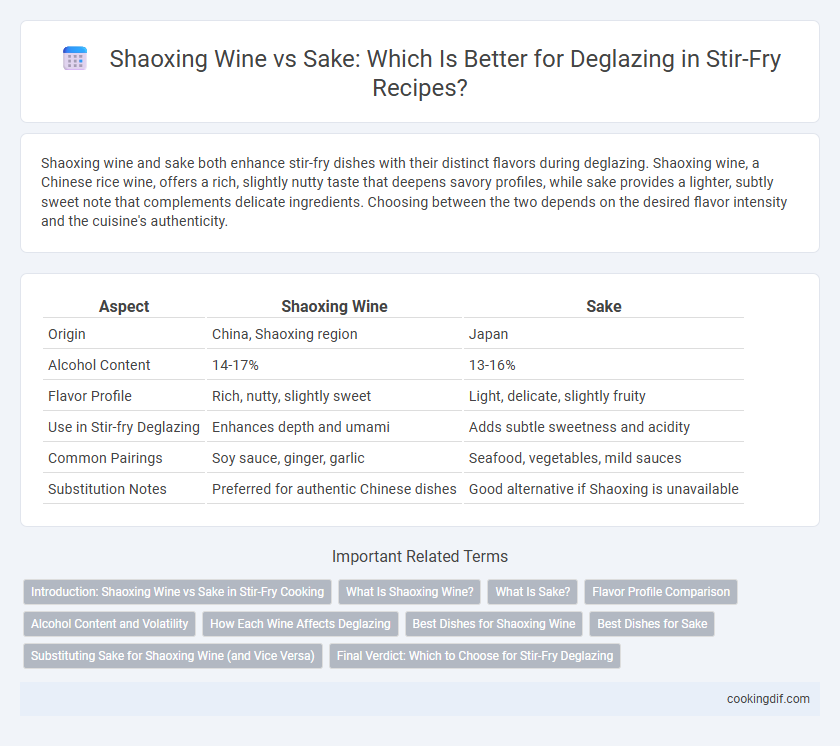Shaoxing wine and sake both enhance stir-fry dishes with their distinct flavors during deglazing. Shaoxing wine, a Chinese rice wine, offers a rich, slightly nutty taste that deepens savory profiles, while sake provides a lighter, subtly sweet note that complements delicate ingredients. Choosing between the two depends on the desired flavor intensity and the cuisine's authenticity.
Table of Comparison
| Aspect | Shaoxing Wine | Sake |
|---|---|---|
| Origin | China, Shaoxing region | Japan |
| Alcohol Content | 14-17% | 13-16% |
| Flavor Profile | Rich, nutty, slightly sweet | Light, delicate, slightly fruity |
| Use in Stir-fry Deglazing | Enhances depth and umami | Adds subtle sweetness and acidity |
| Common Pairings | Soy sauce, ginger, garlic | Seafood, vegetables, mild sauces |
| Substitution Notes | Preferred for authentic Chinese dishes | Good alternative if Shaoxing is unavailable |
Introduction: Shaoxing Wine vs Sake in Stir-Fry Cooking
Shaoxing wine, a traditional Chinese rice wine, offers a richer, nutty flavor profile ideal for authentic stir-fry deglazing compared to sake's lighter, sweet taste derived from Japanese rice fermentation. Using Shaoxing wine in stir-fry enhances umami depth and complexity while helping to tenderize proteins and lift browned bits from the pan, creating a robust sauce base. Sake provides a milder alternative with subtle sweetness, but Shaoxing wine remains the preferred choice for pronounced aroma and savory intensity in classic Chinese stir-fry dishes.
What Is Shaoxing Wine?
Shaoxing wine is a traditional Chinese rice wine renowned for its rich, nutty flavor and amber color, commonly used in stir-fry recipes for deglazing to add depth and complexity. Unlike sake, which is a Japanese rice wine with a lighter, sweeter profile, Shaoxing wine provides a robust umami taste that enhances savory dishes. Incorporating Shaoxing wine in stir-fries helps to lift browned bits from the pan, intensifying aroma and flavor without overpowering the dish.
What Is Sake?
Sake is a traditional Japanese rice wine known for its slightly sweet and umami-rich flavor, often used to deglaze pans in various Asian cuisines. Unlike Shaoxing wine, which originates from China and has a stronger, more robust taste, sake provides a delicate, subtle enhancement that complements seafood and vegetable stir-fries. Using sake for deglazing helps release browned bits from the pan while adding depth without overpowering the dish.
Flavor Profile Comparison
Shaoxing wine offers a rich, nutty, and slightly sweet flavor with earthy undertones, enhancing stir-fry dishes with depth and authenticity. Sake presents a lighter, cleaner taste with subtle fruity and umami notes, contributing a delicate balance to the deglazing process. For stir-fry recipes seeking robust, complex flavors, Shaoxing wine is preferred, while sake suits lighter, more subtle profiles.
Alcohol Content and Volatility
Shaoxing wine typically contains about 14-17% alcohol, providing moderate volatility that enhances deglazing by quickly lifting caramelized bits without overpowering the dish. Sake, with a similar alcohol content around 14-16%, has a slightly lower volatility, resulting in a gentler evaporation during stir-frying. The choice between Shaoxing wine and sake for deglazing depends on the desired intensity of flavor release and the balance of aromatic compounds retained during cooking.
How Each Wine Affects Deglazing
Shaoxing wine enhances deglazing by imparting a rich, nutty aroma and a slightly sweet, umami flavor, which intensifies the depth of stir-fry sauces. Sake, with its lighter, mildly sweet profile and subtle fruity notes, creates a cleaner, more delicate deglaze that highlights the freshness of vegetables and seafood. Choosing Shaoxing wine or sake for deglazing influences the final flavor balance, acidity, and complexity in stir-fry dishes.
Best Dishes for Shaoxing Wine
Shaoxing wine, a traditional Chinese rice wine, excels in deglazing for savory stir-fry dishes like Kung Pao chicken, Mapo tofu, and beef with broccoli, imparting a rich, slightly nutty flavor that enhances umami depth. Its robust aroma and balanced sweetness elevate dishes featuring bold spices and fermented sauces, making it ideal for authentic Chinese cuisine. Unlike sake, which has a lighter, fruitier profile suited for delicate seafood or Japanese stir-fries, Shaoxing wine's complexity complements hearty, intensely flavored stir-fry recipes.
Best Dishes for Sake
Sake excels in deglazing dishes like teriyaki chicken, sukiyaki, and tempura by imparting a subtly sweet and umami-rich flavor that complements delicate seafood and poultry. Its light, refined profile enhances the natural taste of ingredients without overpowering them, making it ideal for Japanese-inspired stir-fries. Shaoxing wine, richer and earthier, is better suited for heartier Chinese stir-fries such as beef and black bean sauce, providing a deeper caramelized aroma.
Substituting Sake for Shaoxing Wine (and Vice Versa)
Shaoxing wine and sake both serve as ideal deglazing agents in stir-fry, enhancing umami while lifting browned bits from the pan. Substituting sake for Shaoxing wine introduces a milder, slightly sweet profile compared to Shaoxing's rich, nutty, and caramel notes, subtly altering the dish's flavor complexity. When using Shaoxing wine in place of sake, expect a deeper, earthier taste that intensifies savory elements, making it essential to adjust seasoning to balance the final sauce.
Final Verdict: Which to Choose for Stir-Fry Deglazing
Shaoxing wine offers a rich, nutty depth with hints of caramel that enhance authentic Chinese stir-fry dishes, making it ideal for deglazing in traditional recipes. Sake provides a lighter, sweeter profile that complements Japanese-style stir-fries but may lack the robust flavor needed for richer sauces. For stir-fry deglazing, Shaoxing wine is generally preferred due to its stronger flavor complexity and better balance with soy-based ingredients.
Shaoxing wine vs sake for deglazing Infographic

 cookingdif.com
cookingdif.com